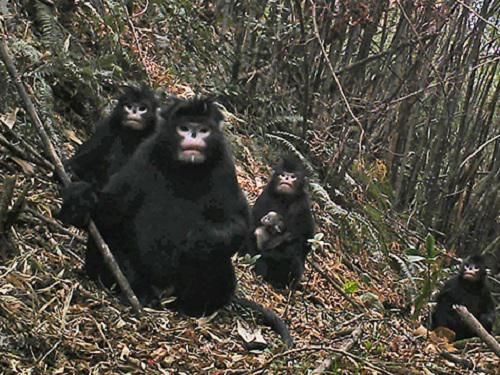Social media article featuring the project.
PhD student devotes eight years to protecting critically endangered snub-nosed monkeys
The Burmese snub-nosed monkey (Rhinopithecus strykeri), categorized as Critically Endangered on the IUCN Red List, only occurs in limited areas of Myanmar and China. However, information on the detailed distribution and conservation status of this species are highly insufficient. Objectives of this project are (1) surveying additional groups of R. strykeri in putative distribution area of Pianma, (2) clarifying the facts threaten its survival, (3) recommending future conservation strategies. This work will provide more detailed information for regional biodiversity conservation efforts, and for further studies on this rare primate.

One-male multi-female unit. ©Yi Xin Chen.
Since its recent discovery in both Myanmar and China, the Burmese snub-nosed monkey Rhinopithecus strykeri (Myanmar snub-nosed monkey, black snub-nosed monkey) remains to be one of enigmatic non-human primate species in the world (Geissmann et al., 2011; Long et al., 2012; Yang et al., 2016; Meyer et al., 2017). However, the International Union for Conservation of Nature (IUCN) has listed R. strykeri as Critically Endangered (CR) due to severe trends on habitat loss and population decline, limited distribution area, and the lack of proper conservation actions (Geissmann et al., 2012).

Juveniles of Burmese snub-nosed monkeys. ©Yi Xin Chen.
Although it is very difficult to get population and distribution status crystal clear in a short period of time, conserving any known groups and its habitat, as well as surveying potential new groups of R. strykeri are imperative (Meyer et al., 2017). As the earliest known distribution area in China, Mt. Gaoligong in Pianma (N 26°31′- 25°33′, E 98°36′- 98°49′), Lushui, western Yunnan province, is critical for survival of R. strykeri (Long et al., 2012; Ma et al., 2014; Chen et al., 2015; Ren et al., 2017). Earlier surveys have confirmed one group occurring within Mt. Gaoligong National Nature Reserve (GNNR) in Pianma, suggesting R. strykeri exhibiting complex multi-level social organization to form large and cohesive group (≥ 100 individuals), and inhabiting in vast mountainous evergreen broadleaf forest (c.a. 22.9 km², 2300 – 3300 m A.S.L) (Li et al., 2014; Chen et al., 2015). However, the presence of other groups, as well as quantified conservation status in Pianma are ambiguous, although human disturbance may still threaten R. strykeri in GNNR and result population decline (Li et al., 2014; Chen et al., 2016).
The aims of this project are (1) surveying additional groups of R. strykeri in putative distribution area of Pianma, (2) clarifying the facts threaten its survival, (3) recommending future conservation strategies. To achieve these goals, we will adopt various field methods (interview, direct observation and infra-red camera trapping) to collect data about distribution, population status of R. strykeri and human disturbance. Data analysis will incorporate group composition analysis, home range and occupancy estimate, and evaluation on human activities which may threaten the species.
We will manage to ensure this project yield valuable information, and to promote practical conservation strategies for Critically Endangered R. strykeri and local biodiversity in Mt. Gaoligong.
Social media article featuring the project.
PhD student devotes eight years to protecting critically endangered snub-nosed monkeys